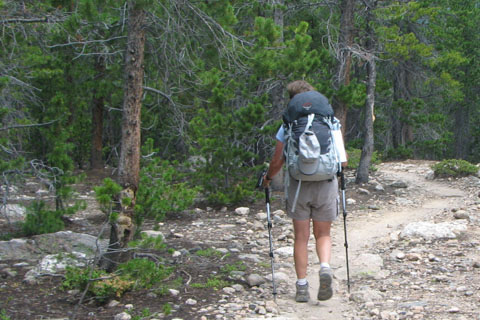| 607 | Trail Sense Packing a Pack |
2012-03-26 |

I have been hiking and camping basically all of my life. Through the years I have learned many lessons, sometimes over and over again.
After carrying heavy loads on a rigid frame Kelty pack for years, I had huge scars on my hips from the chafing. The pack moved one way and I moved the other. Finally, in the late '70's a frameless pack was made that could carry loads. The now obscure, Don Jensen Pack was a heavy duty pack that's structure was defined by dividing the main compartment into two vertical tubes. If the pack was correctly packed it carried like a dream (when compared with my old Kelty), but if you hastily threw your gear into the pack, you were in for a fate worse than you could imagine. The pack had no padding. A misplaced piece of gear would poke and continue to poke you in the back until you finally stopped and re-packed. Despite it's peculiarities the pack is still one of my all time favorites.
In today's packs, the internal frame models seem to dominate the market. The internal frame mixes the flexibility of the frameless pack with the supporting frame of the framed back. With efficient packing you can fill the pack so that it moves with you, not against you.
A few tips on how to pack your pack …
Pack only what you need, not what you think you might use.
If you buy a small pack, you can't pack too much stuff!
Use silnet (lightweight nylon) ditty bags or plastic bags to keep like items together. It is the kit system. Know what is in each kit and where you plan to store it. For example, kits might be - Toilet Kit, First Aid Kit, etc
To generalize packing - heavy things are carried high in the pack and next to your back, if you are scrambling move the heavier items down in the bag (still against your back) to lower your center of gravity
Compression sacks compress the load but sometimes make packing difficult. Packing a compressed sleeping bag is like trying to pack a bowling ball.
Use large stuff sacks (or plastic bags) to put your stored clothes, sleeping bag, and tent inside. The bags need to be lightweight, but large enough to allow the objects inside the bag to conform to the shapes of the pack.
Water is one of the heaviest items that you will carry, keep it high and against your back. Packs designed to be used with a hydration system have a sleeve or area to store the water bladder.
Use the features of the pack. When I carry a bag with a zipper near the bottom of the main compartment, then I am able to pack items low in the bag that I want to be able to be easily accessible. I am not a fan of outside pockets, but Amy loves to use hers to help organize her gear.
Those rigid bear proof containers are difficult to pack. A small bear container can fit inside the pack, but the larger container needs to fit on the outside. The large container fits nicely under the lid of my pack.
Keep items that you need to access the most frequently in the top lid of the pack.
Don't be afraid to experiment.
Buy gear to match your pack. If you are committing to a lightweight design, don't try and pack a sleeping bag that weighs ten pounds! You don't have to buy everything at once, but slowly start upgrading your gear to match your pack.
In my pack, I carry …
- In the bottom of the main compartment (with a bottom zipper): First Aid Kit, Emergency Kit, Toilet Kit
- In the rest of the main compartment (from bottom to top): Clothing, Sleeping Bag, Pad (I have a very compact pad), Tent, and topped off with the Bear Canister (filled with food and cooking gear)
- In the top pocket lid: Medicine Kit, Personal Essentials (sun screen, insect spray, toothbrush, etc), headlamp, wallet, keys, etc
- I carry a GPS, camera, and batteries in a separate pouch.
After packing your pack be sure to take it for a test drive. Re-pack if needed.
Happy backpacking trails